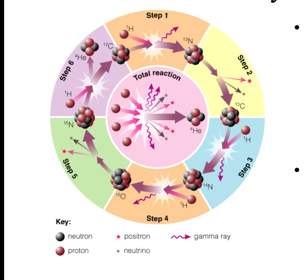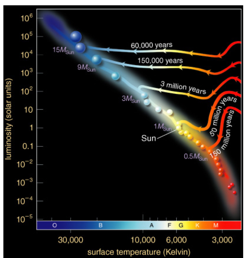Sign up for FlowVella
Sign up with FacebookAlready have an account? Sign in now
By registering you are agreeing to our
Terms of Service
Loading Flow

CNO Cycle
• High-massmain sequence stars fuse H to He at a higher rate using carbon, nitrogen, and oxygen as catalysts
• Greatercore temperature enables H nuclei to overcome greater repulsion
Life Tracks for Different Masses
• Modelsshowthat Sun required about 30 million years to go from protostar to main sequence
• Higher-massstars form faster
• Lower-massstars form more slowly
High Mass Stars
1. L∝M3;Fuel∝M
⇒ Lifetime ∝ 1/M2 (M/ M3) Massive stars live fast, die young (shorter lifetimes in all phases)
2. Higher T ⇒ CNO Cycle on M/S
3. No core degeneracy (higher T ⇒
higher P) means no helium flash
4. Higher T ⇒ more nuclear burning stages (it is the high mass stars that make the elements heavier than C,N,O and even most of the C,N,O that goes into the ISM.
5. Massive stars will have very different evolutionary endpoints (remnants: neutron star or black hole vs white dwarf)
High mass stars pre-information

